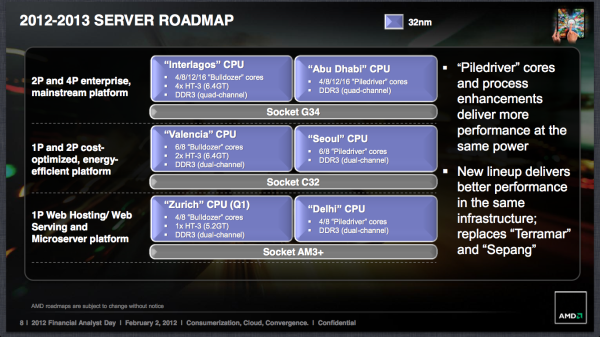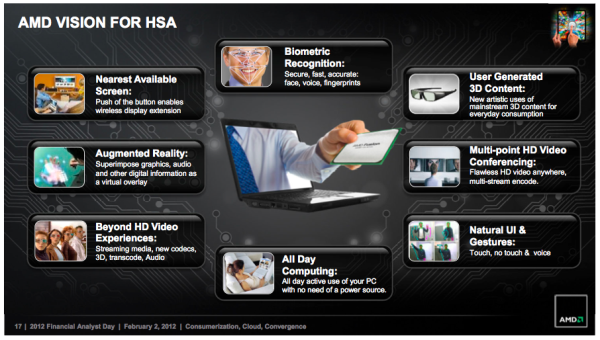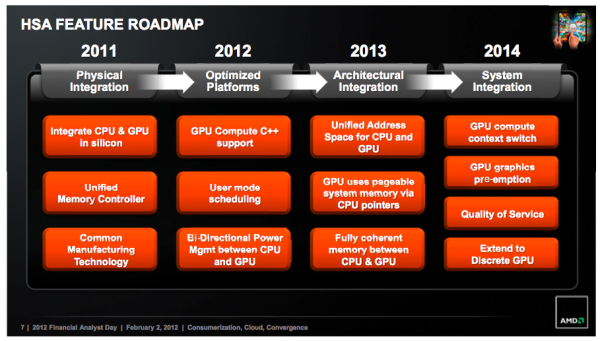Understanding AMD's Roadmap & New Direction
by Anand Lal Shimpi on February 2, 2012 6:16 PM EST- Posted in
- CPUs
- AMD
- Trade Shows
- AMD FAD 2012
The New Focus: Client Mobility
For years we had asked for lower power AMD mobile solutions. While we finally started seeing some progress over the past couple of years, AMD is now very committed to building mobile devices. Anything tablet sized or above is now AMD's target for client APUs.
AMD was always the high-end x86 CPU alternative to Intel in the PC space, now AMD is going to be the alternative in the ultra mobile space.
Servers & the High End Desktop
AMD's server roadmap for the next two years is a bit more conservative. We'll see Piledriver updates from top to bottom but there's no significant departure from the way things are done today. There are no plans for any new sockets in the near term, just using existing platforms to grow AMD's server marketshare without huge new investments.
As AMD's client strategy is predominantly built around APUs, the only high-end desktop parts we'll see from AMD are low-end server CPUs. Socket-AM3+ has a future for one more generation and we'll likely see other single-socket, high-end platforms for the desktop. The days of AMD chasing Intel for the high-end desktop market are done though. That war is officially over.
The Ace: HSA
AMD isn't going to have the fastest general purpose x86 CPUs on the market and it is no longer interested in pursuing that goal. It does promise to have much better on-die GPU performance than Intel. For users today that's primarily an advantage in 3D gaming. As more workloads shift to the GPU however, AMD could have a significant advantage here. The problem is that seamlessly scheduling client workloads across CPUs and GPUs just hasn't happened, the two islands of compute horsepower have remained discrete - even on the new wave of integrated APUs.
AMD's Heterogenous Systems Architecture (HSA) plans to change that. AMD wants to see the creation of a virtual ISA that will be the backbone of a software layer that can schedule application workloads on any combination of underlying CPU/GPU hardware, regardless of the ISA of the hardware. If you have a workload that's best run on big, general purpose x86 cores, that's where it will run. If a task is better designed for highly parallel GPUs cores, it'll run there. And presumably if you had an ARM core somewhere underneath and the workload would run better on it, you'd be covered as well.
AMD plans on delivering an HSA enabled GPU family by 2014, with today's Graphics Core Next GPUs being an intermediary step that already fill a number of these goals. These HSA GPUs would be able to share the same memory space as CPUs and work seamlessly as coprocessors. Granted AMD doesn't have the best track record of quickly moving the industry with things like HSA (although AMD64 did work out quite well), so we'll have to wait and see how all of this plays out.
If AMD can get broad industry support for HSA then its APUs become much more attractive. The overall performance of AMD solutions would then become more compelling as they'd take both CPU and GPU architectures into account, again assuming the workloads require both.













84 Comments
View All Comments
haplo602 - Friday, February 3, 2012 - link
Funny how AMD anticipated some of my changes in hardware preference. I moved to a socket F dual opteron board. in 2 years time, I'll change it for another dual opteron board.The other end goes into my living room as a HTPC next to the TV for the wife (Internet) and kids (low end gaming).
R3MF - Friday, February 3, 2012 - link
i am disappointed in their desktop roadmap.ditching sepang/terramar means no on-die PCIe 3.0 controller, and relying on an aging chipset stuck with off-die PCIe 2.0. also means no triple-channel memory in the enthusiast space either.
and not only for 2012, but for much of 2013 as well!
R3MF - Friday, February 3, 2012 - link
steve from H thinks its AM2, which i believe the socket that high-end desktop will migrate too from AM3+ next year, so good upgrade path.but is he right?
and am i right?
BPB - Friday, February 3, 2012 - link
The simple fact of the matter is the vast majority of folks today don't need anything near high end CPUs. If you are gaming at 1920x1200 or lower, middle of the road cpus and gpus do the trick fine. From what I've read most folks are 1920x1080 or lower, with many at 1680x1050 or lower. My 3 year old AMD box does fine for almost all current games (1920x1200). It's only a couple that recently came out that have me considering a new video card. Even then I'll probably get a 6800 series from AMD, unless a cheaper 7000 series card comes out soon.Yuriman - Sunday, February 5, 2012 - link
Very true, but Intel beats AMD in price/performance AND power/performance and the disparity is only going to grow if AMD keeps adding transistors on old processes. I'm glad AMD is ditching high end CPUs, there's a lot of R&D money there that would be of great benefit elsewhere.It's definitely time for both companies to start building down. I want a netbook that doesn't suck, and since the PC gaming market is so stagnant, any gaming PCs I build will likely be small, quiet, and sip power.
rocketbuddha - Friday, February 3, 2012 - link
Anand, did you get clarity from AMD as to what would be the non-SOI 28nm node to be in use?GF or TSMC?
If Brazos 2.0 is going to be in 40nm then that means that AMD mistakenly bet that GF 28nm will be ready in 2012. Else what is the use of introducing Brazos 2 in 40nm node while TSMC 28nm is now manufacturing Krait and soon TI OMAP5.
So AMD either can trust GF will get 28nm in 2013 or use TSMC 28nm (which it has some familiarity manufacturing Discrete Graphics chips). Last year there were some articles in Extremetech by Joel Hruska
http://www.extremetech.com/computing/106217-manufa...
as to AMD going to TSMC for 28nm non SOI APU manufacturing..
If true Jaguar series will be 28nm TSMC HKMG, while for Kaveri (Trinity successor) as well as BD2 and successors AMD has no choice but to use GF SOI processes.
Assuming that Steamroller is BD2, Piledriver is enhanced BD, looks like even in 2013 AMD expects the best SHP SOI process available at Global Foundries would be 28nm. Man! and Intel is supposed to go to 22nm in the middle of this year. Even in 2013 AMD is not sure GF would have a 20nm SOI node ready. Sucks! Let us hope STMicro comes close enough to providing AMD with a choice of foundries.
sapi3n - Friday, February 3, 2012 - link
I built a phenom II X6 and AMD 5870 system w/ 16 gigs ram, an SSD, and several 1TB drives, which does crunch pretty well in After Effects, but I wasn't able to get an HDMI capture card to work (Blackmagic prefers intel?) - so do not have that capability, no Mercury Engine Playback support in Premiere (Cuda only), and no 64-bit firewire support on the motherboard (the Asus M4A89TD- Pro's integrated ports do not work with my camera) - very frustrating to have all these problems that wouldn't exist with an intel/nvidia build.jabber - Friday, February 3, 2012 - link
So what you are saying is...you didn't do your homework?Not really the fault of AMD is it?
sapi3n - Saturday, February 4, 2012 - link
no way to test blackmagic without taking the plunge - by the way their support is horrible - fair warning - otherwise, i was under the impression that all cards with current open GL specs would help accelerate Adobe software, which is true - but premiere's mercury playback engine is cuda only - if i'd have known that, I would have purchased differently.sapi3n - Saturday, February 4, 2012 - link
what about buying a game that has physX support, with features turned off for your $500 AMD card - you're fu$$ed.